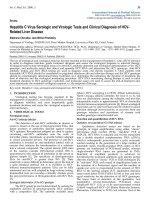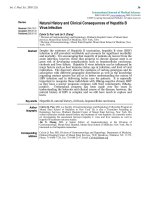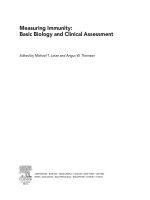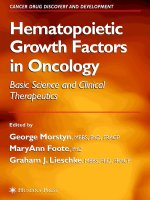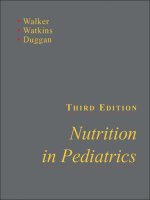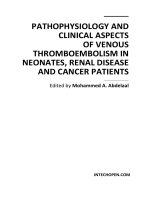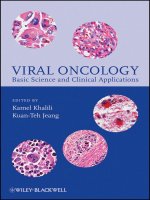RADIATION IN TISSUE BANKING Basic Science and Clinical Applications of Irradiated Tissue Allografts doc
Bạn đang xem bản rút gọn của tài liệu. Xem và tải ngay bản đầy đủ của tài liệu tại đây (3.86 MB, 584 trang )
RADIATION IN
TISSUE BANKING
Basic Science and Clinical Applications
of Irradiated Tissue Allografts
March 19, 2007 14:26 b478 Radiation in Tissue Banking Trim Size: 9in x 6in FM FA
This page intentionally left blankThis page intentionally left blank
N E W J E R S E Y
•
L O N D O N
•
S I N G A P O R E
•
B E I J I N G
•
S H A N G H A I
•
H O N G K O N G
•
T A I P E I
•
C H E N N A I
World Scientic
RADIATION IN
TISSUE BANKING
Basic Science and Clinical Applications
of Irradiated Tissue Allografts
Aziz Nather
Norimah Yusof
Nazly Hilmy
E d i t o r s
National University of Singapore, Singapore
BATAN Research Tissue Bank, Indonesia
Malaysian Nuclear Agency, Malaysia
British Library Cataloguing-in-Publication Data
A catalogue record for this book is available from the British Library.
For photocopying of material in this volume, please pay a copying fee through the Copyright
Clearance Center, Inc., 222 Rosewood Drive, Danvers, MA 01923, USA. In this case permission to
photocopy is not required from the publisher.
ISBN-13 978-981-270-590-7
ISBN-10 981-270-590-2
Typeset by Stallion Press
Email:
All rights reserved. This book, or parts thereof, may not be reproduced in any form or by any means,
electronic or mechanical, including photocopying, recording or any information storage and retrieval
system now known or to be invented, without written permission from the Publisher.
Copyright © 2007 by World Scientific Publishing Co. Pte. Ltd.
Published by
World Scientific Publishing Co. Pte. Ltd.
5 Toh Tuck Link, Singapore 596224
USA office: 27 Warren Street, Suite 401-402, Hackensack, NJ 07601
UK office: 57 Shelton Street, Covent Garden, London WC2H 9HE
Printed in Singapore.
RADIATION IN TISSUE BANKING
Basic Science and Clinical Applications of Irradiated Tissue Allografts
Wanda - Radiation in Tissue Banking.pmd 5/25/2007, 10:16 AM1
March 19, 2007 14:26 b478 Radiation in Tissue Banking Trim Size: 9in x 6in FM FA
Foreword from the Chairman of the National
Nuclear Energy Agency of Indonesia (BATAN)
First, I would like to congratulate the authors and editors of this book for
their excellent work in promoting the application of nuclear technology
in tissue banking. I believe that this book will contribute significantly in
meeting the need for relevant, qualified applications of irradiated tissue
allografts in response to the increasing worldwide demand.
Increasing demands for surgical allografts such as bone, amnion, fas-
cia, tendon, skin, and cardiovascular tissue have to be supported by the
increasing quality and safety of these products for safe clinical use. The
quality, sterility, and safety aspects of tissue bank products are analogous
with the preparation of pharmaceuticals and medical devices in the man-
ufacturing industry. The elimination of disease transmission from donor
to recipient, especially the diseases caused by viruses, necessitates thor-
ough donor screening, although (1) viruses at the window period and new
emerging viruses may not be detected and (2) several diseases can still be
transmitted through transplantation. These phenomena were reported by the
Centers for Disease Control and Prevention (CDC) in the USA in 2003. The
implementation of a quality system in tissue banking activities and the radi-
ation sterilization of end products have been proven by several researchers
around the world to be beneficial in overcoming these problems.
Radiation technology for the sterilization of healthcare products was
first utilized in 1956 in the UK and Australia, and has since been followed
by other countries such as the USA, Scandinavian countries, and other
European countries. At present, more than 200 gamma irradiators of cobalt-
60 and about 10 electron beam machines have been installed to sterilize
around 40% of disposable healthcare products around the world.
In 1983, an Asia-Pacific regional project on the Radiation Sterilization
of Tissue Grafts (RAS/7/003) was established by the International Atomic
Energy Agency (IAEA), followed by a program on the Implementation of
v
March 19, 2007 14:26 b478 Radiation in Tissue Banking Trim Size: 9in x 6in FM FA
vi Foreword
Quality Systems in the Radiation Sterilization of Tissue Grafts for safe
clinical use (RAS/7/008). Under the IAEA project (INT/6/052), two valu-
able standards were published: the IAEA International Standards for Tissue
Banks (2002), and the IAEA Code of Practice for the Radiation Steriliza-
tion of Tissue Allografts (2004). May I take this opportunity to thank the
IAEA for its efforts to establish several tissue banks in some countries in the
Asia-Pacific region, as well as for carrying out training for potential users
of tissue allografts and conducting diploma courses for tissue bankers that
complete and enhance tissue banking activities in developing countries.
This book is certainly very useful to support one of the main pillars —
the application of isotope and radiation technology — being developed
by BATAN to enhance the contribution of nuclear techniques in health.
I am confident that this book will also contribute to achieve one of the
main millennium development goals, i.e. health, which is of paramount
importance especially for countries in the Asia-Pacific region.
Professor Soedyartomo Soentono, MSc, PhD
Chairman
National Nuclear Energy Agency of Indonesia (BATAN)
Jakarta, Indonesia
December 2006
March 19, 2007 14:26 b478 Radiation in Tissue Banking Trim Size: 9in x 6in FM FA
Foreword from the Director-General of the
Malaysian Nuclear Agency (NM)
Radiation technology plays a vital role in the healthcare industry, with
gamma irradiation used worldwide to sterilize more than 45% of all dis-
posable medical products and devices. The radiation sterilization of tissue
allografts — which was promoted by the International Atomic Energy
Agency (IAEA) through regional and interregional programs from the 1990s
to the early 2000s — highlights the peaceful use of nuclear technology in
the health sector. In Malaysia, the Malaysian Nuclear Agency (or Nuclear
Malaysia, NM) has played a big role in the establishment of the National
Tissue Bank at the University of Science Malaysia and bone banks at sev-
eral hospitals. NM also assists in radiation-sterilizing allografts processed
by these banks as well as those from neighboring countries.
At a regional level, most of the tissue banks in the Asia-Pacific region
have chosen gamma irradiation to sterilize their tissues. The supply of
radiation-sterilized tissue allografts has met the expectations of end-users
and clinicians. However, the sustainability of the supply of quality tissues
is very much dependent on the availability of trained manpower to continue
with the operation of tissue banks and ensure that the products are clinically
safe. The availability of reading materials and textbooks is undoubtedly
important in the training of manpower. Therefore, this publication is timely
by helping readers keep abreast with the most recent developments in tissue
banking. I hope that this book will serve as a useful reference, since it is
authored by those who have been actively involved in tissue banking for
many years.
May I congratulate the authors and editors for their dedicated effort
in publishing this book. I am sure the book will not only be useful for
vii
March 19, 2007 14:26 b478 Radiation in Tissue Banking Trim Size: 9in x 6in FM FA
viii Foreword
operators in tissue banking, but will also be a good and handy reference for
young clinicians who intend to know more about the potential use of tissue
grafts.
Daud Mohamad, PhD
Director-General
Malaysian Nuclear Agency (NM)
Ministry of Science, Technology and Innovation
Bangi, Selangor, Malaysia
December 2006
March 19, 2007 14:26 b478 Radiation in Tissue Banking Trim Size: 9in x 6in FM FA
Preface
AZIZ NATHER
NUH Tissue Bank
Department of Orthopaedic Surgery
Yong Loo Lin School of Medicine
National University of Singapore
Singapore
At present, gamma irradiation has yet to be used in the processing of tissue
allografts by all tissue banks. The Massachusetts General Hospital Tissue
Bank in Boston —set upin 1990by thepioneer Dr Henry J. Mankin —is still
a surgical tissue bank employing sterile procurement and processing tech-
niques, but not gamma irradiation (Mankin was succeeded by Dr William
Tomford). Similarly, in Latin America, the Musculoskeletal Tissue Bank in
Latin Hospital, Buenos Aires, Argentina, set up by another famous pioneer
Dr Ottolenghi (now run by Dr Musculo), is also a surgical tissue bank. In
Europe, the largest tissue bank, the DIZG Tissue Bank, set up by Dr von
Versen, employs only chemical processing and does not use radiation.
In Singapore, Dr Nather started a surgical tissue bank at the National
University Hospital(NUH) in 1988, andconverted to using radiation in 1992
upon joining the International Atomic Energy Agency (IAEA) Program
RAS 7/008: “Radiation Sterilization of Tissue Grafts”. In the Asia-Pacific
region, several tissue banks (e.g. in Korea and Japan) started likewise as
surgical tissue banks, but were required to employ radiation as the end-
processing sterilization step upon joining RAS 7/008. There is no doubt
that the IAEA Program on Tissue Banking RAS 7/008 (1985–2004) has
promoted the use of gamma irradiation in the Asia-Pacific region, and that
its corresponding program in Latin America (ARCAL) has promoted the
use of irradiation in Latin American tissue banks.
Today, the benefits of gamma irradiation are well recognized. There is
now a move in the USA to use gamma irradiation; no tissue bank in the
ix
March 19, 2007 14:26 b478 Radiation in Tissue Banking Trim Size: 9in x 6in FM FA
x Preface
USA has ever used irradiation before. In Australia, the Therapeutic Goods
Administration Act lists gamma irradiation as compulsory. A move is being
made from the traditional 25 kiloGrays (kGy) used for gamma irradiation
to 15 kGy — a step that is made possible by the use of clean processing
room facilities to reduce the bioburden of the tissues being processed.
Because of the many incidences of disease transmission (especially in
the USA, a country that does not use gamma irradiation) and because of the
growing professional awareness of the many benefits of gamma irradiation
(including the fact that radiation guarantees product sterility, something a
surgical tissue bank can never do), radiation is now becoming a necessity
in the processing of tissue grafts. As the standards for tissue banking by the
American Association of Tissue Banks (AATB), European Association of
Tissue Banks (EATB), Asia Pacific Association of Surgical Tissue Banks
(APASTB), Australian Tissue Bank Forum (ATBF), and Latin American
Association of Tissue Banks (ALABAT) are continually being renewed and
upgraded, radiation is expected to constitute an integral part of the standards
in all regions in the near future.
This book addresses the controversies surrounding gamma irradiation
and its role in tissue banking. The dosage required to be delivered to the
tissues is itself an enigma. Why is 25 kGy advocated? What is the evidence
for such a dose? Why does Dr Dziedzic-Goclowska, an eminent radiation
biologist at the Central Tissue Bank, Warsaw, Poland, advocate the use of
35 kGy? Australia — a country with the best regulations as well as compul-
sory auditing and licensing — is now seeking to implement a much lower
dose of 15 kGy. How is this possible? With 15 kGy, could we not now also
irradiate soft tissues? Until today, soft tissues have never been irradiated
for fear that the dose of 25 kGy is too large and could weaken the collagen
structure of tendons and ligaments. These and many more issues important
to transplantation surgeons and tissue bankers alike will be discussed in
detail in this book.
The book begins in Part I with a description of the many types of terminal
sterilization that can be used for the processing of tissue grafts, and then
sets the stage for why gamma irradiation is the preferred method.
Part II deals with some of the basic issues in tissue banking. These
include the developmental history of tissue banking in the Asia-Pacific
region; ethical, religious, legal, and cultural issues relating to tissue donors in
Asia-Pacific countries; the requirements of setting up a tissue bank; and the
March 19, 2007 14:26 b478 Radiation in Tissue Banking Trim Size: 9in x 6in FM FA
Preface xi
training requirements needed for all tissue bank operators to provide good-
quality control of tissue allografts for safe tissue transplantation practice.
Part III deals with the core issues of the basic science of radiation. How
do tissues react to radiation, and what are the different types of radiation
and irradiation facilities available? The radiation killing effects on bacteria
and fungi are discussed. The effects of gamma irradiation on new emerging
infectious diseases caused by viruses and prions, as well as on the biome-
chanical properties of bone and amnion, are also included.
Part IV deals with the processing and quality control of radiation. It
covers dosimetry, requirements for process qualification, validation of the
radiation dose delivered, and the importance of bioburden estimation. It
discusses in great depth the various validation methods for the processing of
freeze-dried bone grafts, amnion grafts, and femoral heads. It also includes
dose setting and validation according to the IAEA Code of Practice (2004),
as well as a quality system for the radiation sterilization of tissue grafts.
The clinical applications of irradiated bone grafts are described in Part V,
and the applications of irradiated amnion grafts in Part VI.
This book includes three valuable sources of information in the Appen-
dices: the Asia-Pacific Association of Surgical Tissue Banks (APASTB)
Standards for Tissue Banking (January 2007), the IAEA Code of Practice for
the Radiation Sterilization of Tissue Allografts (2004), and the IAEA Public
Awareness Strategies for Tissue Banks (August 2002). The last appendix is
particularly useful for tissue banks with a shortage of donors, as it provides
a good guide on how to run public awareness campaigns.
This book is unique and very useful, as it provides a one-stop forum for
tissue bankers who procure and process the grafts, radiation scientists who
irradiate the grafts as the final processing step, and transplantation surgeons
who use the irradiated products to learn about the latest developments in
this multidisciplinary field of tissue banking and transplantation. The book
is also a useful text for all tissue bankers, radiation scientists, and surgeons
undergoing training in this field. This is especially so for participants of the
National University of Singapore (NUS) distance learning Diploma Course
in Tissue Banking, which is run by the IAEA/NUS International Training
Centre in Singapore for the Asia-Pacific region, Latin America, Africa,
and Europe; and also for participants of national training courses run by
countries such as Korea.
March 19, 2007 14:26 b478 Radiation in Tissue Banking Trim Size: 9in x 6in FM FA
This page intentionally left blankThis page intentionally left blank
March 19, 2007 14:26 b478 Radiation in Tissue Banking Trim Size: 9in x 6in FM FA
Contents
Foreword Chairman of BATAN & Director-General of NM v
Preface ix
Aziz Nather
List of Contributors xvii
Part I TERMINAL STERILIZATION OF TISSUE
GRAFTS 1
Chapter 1 Types of Terminal Sterilization of Tissue Grafts 3
Aziz Nather, Jocelyn L. L . Chew and Zameer Aziz
Chapter 2 Need for Radiation Sterilization of Tissue Grafts 11
Norimah Yusof and N a zly Hilmy
Part II TISSUE BANKING 23
Chapter 3 Tissue Banking in the Asia-Pacific Region —
Past, Present, and Future 25
Aziz Nather, Kamarul Ariffin Khalid and Eileen Sim
Chapter 4 Ethical, Religious, Legal, and Cultural Issues in Tissue
Banking 55
Aziz Nather, Ahmad Hafiz Zulkifly and Eileen Sim
Chapter 5 Setting Up a Tissue Bank 67
Aziz Nather and C hris C. W. Lee
Chapter 6 A Comprehensive Training System for Tissue Bank
Operators — 10 Years of Experience 83
Aziz Nather, S. H. Neo and Chris C. W. Lee
xiii
March 19, 2007 14:26 b478 Radiation in Tissue Banking Trim Size: 9in x 6in FM FA
xiv Contents
Part III BASIC SCIENCE OF RADIATION 97
Chapter 7 Interaction of Radiation with Tissues 99
Norimah Yusof
Chapter 8 Types of Radiation and Irradiation Facilities for
Sterilization of Tissue Grafts 109
Norimah Yusof, N oriah Mod Ali and Nazly Hilmy
Chapter 9 Radiation Killing Effects on Bacteria and Fungi 121
Norimah Yusof
Chapter 10 New Emerging Infectious Diseases Caused by Viruses
and Prions, and How Radiation Can Overcome Them 133
Nazly Hilmy and Paramita Pandansari
Chapter 11 Effects of Gamma Irradiation on the
Biomechanics of Bone 147
Aziz Nather, Ahmad Hafiz Zulkifly and Shu-Hui Neo
Chapter 12 Physical and Mechanical Properties of
Radiation-Sterilized Amnion 155
Norimah Yusof and Nazly Hilmy
Part IV PROCESSING AND QUALITY CONTROL 169
Chapter 13 Dosimetry and Requirements for Process Qualification 171
Noriah Mod Ali
Chapter 14 Validation of Radiation Dose Distribution in Boxes for
Frozen and Nonfrozen Tissue Grafts 187
Norimah Yusof
Chapter 15 Importance of Microbiological Analysis in
Tissue Banking 201
Norimah Yusof and Asnah Hassan
Chapter 16 Validation for Processing and Irradiation
of Freeze-Dried Bone Grafts 219
Nazly Hilmy, Basril Abbas and Febrida Anas
March 19, 2007 14:26 b478 Radiation in Tissue Banking Trim Size: 9in x 6in FM FA
Contents xv
Chapter 17 Validation for Processing and Irradiation
of Amnion Grafts 237
Nazly Hilmy, Basril Abbas and Febrida Anas
Chapter 18 Validating Pasteurization Cycle Time for
Femoral Head 249
Norimah Yusof and Selam at S. Nadir
Chapter 19 Radiation Sterilization Dose Establishment for
Tissue Grafts — Dose Setting and Dose Validation 259
Norimah Yusof
Chapter 20 Quality System in Radiation Sterilization
of Tissue Grafts 275
Nazly Hilmy
Part V CLINICAL APPLICATIONS OF
IRRADIATED BONE GRAFTS 303
Chapter 21 Clinical Applications of Gamma-Irradiated
Deep-Frozen
and Lyophilized Bone Allografts — The NUH
Tissue Bank Experience 305
Aziz Nather, Kamarul Ariffin Khalid and Za meer Aziz
Chapter 22 Use of Freeze-Dried Irradiated Bones in
Orthopedic Surgery 317
Ferd iansyah
Part VI CLINICAL APPLICATIONS OF
IRRADIATED AMNION GRAFTS 327
Chapter 23 The Use of Irradiated Amnion Grafts in
Wound Healing 329
Menkher Manjas, Petrus Tarusaraya and Nazly Hilmy
Chapter 24 Amnion for Treatment of Burns 343
Hasim Mohamad
March 19, 2007 14:26 b478 Radiation in Tissue Banking Trim Size: 9in x 6in FM FA
xvi Contents
Chapter 25 Use of Freeze-Dried Irradiated Amnion in
Ophthalmologic Practices 355
Nazly Hilmy, Paramita Pandansari, Getry Sukmawati
Ibrahim, S. Indira, S. Bambang, Radiah Sunarti
and Susi Heryati
Chapter 26 Clinical Applications of Irradiated Amnion Grafts:
Use of Amnion in Plastic Surgery 365
Ahmad Sukari Halim, Aik-Ming Leow,
Aravazhi Ananda Dorai and Wan Azman Wa n Sulaiman
APPENDICES 381
Appendix 1 Asia Pacific Association of Surgical Tissue Banks
(APASTB) Standards for Tissue Banking 383
Aziz Nather, Norimah Yusof, Nazly H ilmy,
Yong-Koo Kang, Astrid L. Gajiwala, Lyn Ireland,
Shekhar Kumta and Chang-Joon Yim
Appendix 2 International Atomic Energy Agency (IAEA) Code of
Practice for the Radiation Sterilization of Tissue
Allografts: Requirements for Validation and
Routine Control (2004) 443
Appendix 3 The IAEA Program on Radiation and Tissue
Banking — Public Awareness Strategies for Tissue
Banks (2002) 501
Index 545
March 19, 2007 14:26 b478 Radiation in Tissue Banking Trim Size: 9in x 6in FM FA
LIST OF CONTRIBUTORS
Basril Abbas
BATAN Research Tissue Bank (BRTB)
Center for Research and Development
of Isotopes and Radiation Technology
BATAN, Jakarta 12070
Indonesia
Noriah Mod Ali
Secondary Standard Dosimetry Laboratory (SSDL)
Malaysian Nuclear Agency (NM)
Bangi, 43000 Kajang, Selangor
Malaysia
Febrida Anas
BATAN Research Tissue Bank (BRTB)
Center for Research and Development
of Isotopes and Radiation Technology
BATAN, Jakarta 12070
Indonesia
Zameer Aziz
NUH Tissue Bank
Department of Orthopaedic Surgery
Yong Loo Lin School of Medicine
National University of Singapore
Singapore
S. Bambang
Cicendo Eye Hospital, Faculty of Medicine
Padjajaran University, Bandung
Indonesia
xvii
March 19, 2007 14:26 b478 Radiation in Tissue Banking Trim Size: 9in x 6in FM FA
xviii List of Contributors
Jo celyn L. L. Chew
NUH Tissue Bank
Department of Orthopaedic Surgery
Yong Loo Lin School of Medicine
National University of Singapore
Singapore
Aravazhi Ananda Dorai
Reconstructive Sciences Department
School of Medical Sciences, Health Campus
Universiti of Science Malaysia
16150 Kubang Kerian, Kelantan
Malaysia
Ferd iansyah
Biomaterial Center – “Dr Soetomo” Tissue Bank
Department of Orthopaedics and Traumatology
Dr Soetomo General Hospital
Airlangga University School of Medicine, Surabaya
Indonesia
Ahmad Sukari Halim
Reconstructive Sciences Department
School of Medical Sciences, Health Campus
Universiti of Science Malaysia
16150 Kubang Kerian, Kelantan
Malaysia
Asnah Hassan
Malaysian Nuclear Agency (NM)
Bangi, 43000 Kajang, Selangor
Malaysia
Susi Heryati
Cicendo Eye Hospital, Faculty of Medicine
Padjajaran University, Bandung
Indonesia
March 19, 2007 14:26 b478 Radiation in Tissue Banking Trim Size: 9in x 6in FM FA
List of Contributors xix
Nazly Hilmy
BATAN Research Tissue Bank (BRTB)
Center for Research and Development
of Isotopes and Radiation Technology
BATAN, Jakarta 12070
Indonesia
Getry Sukmawati Ibrahim
Department of Ophthalmology
Faculty of Medicine
Andalas University/M. Djamil Hospital
Padang
Indonesia
S. Indira
Cicendo Eye Hospital, Faculty of Medicine
Padjajaran University, Bandung
Indonesia
Kamarul Ariffin Khalid
Department of Orthopaedics, Traumatology and Rehabilitation
Kulliyah of Medicine
International Islamic University Malaysia
Malaysia
ChrisC.W.Lee
NUH Tissue Bank
Department of Orthopaedic Surgery
Yong Loo Lin School of Medicine
National University of Singapore
Singapore
Aik-Ming Leow
Reconstructive Sciences Department
School of Medical Sciences, Health Campus
Universiti of Science Malaysia
16150 Kubang Kerian, Kelantan
Malaysia
March 19, 2007 14:26 b478 Radiation in Tissue Banking Trim Size: 9in x 6in FM FA
xx List of Contributors
Menkher Manjas
M. Djamil Hospital Tissue Bank
Department of Surgery, Faculty of Medicine
Andalas University, Padang
Indonesia
Hasim Mohamad
School of Medical Science
University of Science, Malaysia
Malaysia
and
Department of Surgery
Hospital Raja Perempuan Zainab II
Kota Bharu
Malaysia
Selamat S. Nadir
Malaysian Nuclear Agency (NM)
Bangi, 43000 Kajang, Selangor
Malaysia
Aziz Nather
NUH Tissue Bank
Department of Orthopaedic Surgery
Yong Loo Lin School of Medicine
National University of Singapore
Singapore
S H. Neo
NUH Tissue Bank
Department of Orthopaedic Surgery
Yong Loo Lin School of Medicine
National University of Singapore
Singapore
Paramita Pandansari
BATAN Research Tissue Bank (BRTB)
Center for Research and Development
of Isotopes and Radiation Technology
BATAN, Jakarta 12070
Indonesia
March 19, 2007 14:26 b478 Radiation in Tissue Banking Trim Size: 9in x 6in FM FA
List of Contributors xxi
Eileen Sim
NUH Tissue Bank
Department of Orthopaedic Surgery
Yong Loo Lin School of Medicine
National University of Singapore
Singapore
Wan Azman Wan Sulaiman
Reconstructive Sciences Department
School of Medical Sciences, Health Campus
Universiti of Science Malaysia
16150 Kubang Kerian, Kelantan
Malaysia
Radiah Sunarti
Cicendo Eye Hospital, Faculty of Medicine
Padjajaran University, Bandung
Indonesia
Petrus Tarusaraya
Sitinala Leprosy Hospital
Tangerang
Indonesia
Norimah Yusof
Malaysian Nuclear Agency (NM)
Bangi, 43000 Kajang, Selangor
Malaysia
Ahmad Hafiz Zulkifly
Department of Orthopaedics, Traumatology and Rehabilitation
Kulliyah of Medicine
International Islamic University Malaysia
Malaysia
March 19, 2007 14:26 b478 Radiation in Tissue Banking Trim Size: 9in x 6in FM FA
This page intentionally left blankThis page intentionally left blank
March 15, 2007 22:3 b478 Radiation in Tissue Banking Trim Siz e: 9in x 6in ch01 FA
PART I.
TERMINAL STERILIZATION OF TISSUE
GRAFTS
March 15, 2007 22:3 b478 Radiation in Tissue Banking Trim Size: 9in x 6in ch01 FA
This page intentionally left blankThis page intentionally left blank
